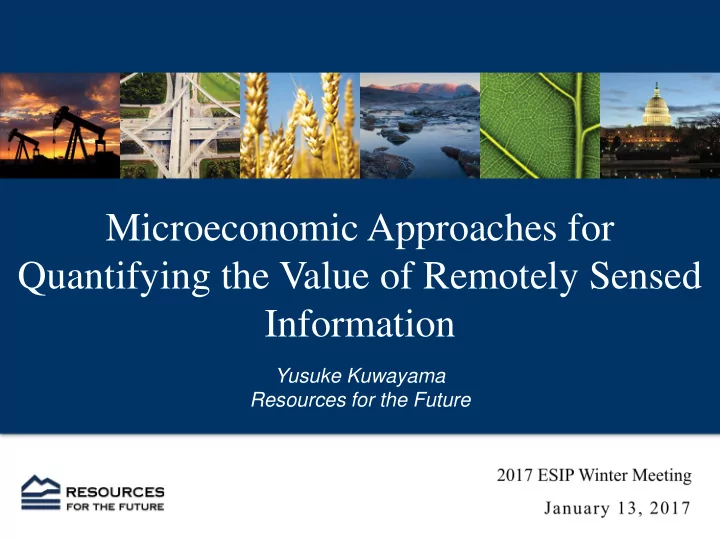

Microeconomic Approaches for Quantifying the Value of Remotely Sensed Information Yusuke Kuwayama Resources for the Future
Outline 1. Introduction 2. What is the Value of Information (VOI)? 3. Examples of microeconomic VOI studies 4. Barriers to quantification and communication 5. The VALUABLES Consortium 2
Introduction: Measuring the value of data • Why is it important? • Characterizes the value proposition of Earth observations; • Substantiates the benefits of Earth science applications in socially and economically meaningful terms; • Communicates those benefits to audiences beyond the Earth science community; and • Can support applications-driven directions for research. • Approaches: • Qualitative or quantitative • Revealed or stated preferences • Ex post or ex ante • Microeconomic or macroeconomic 3
What is the Value of Information (VOI)? • The Value of Information (VOI): The gains that result from making better decisions that are based on additional information in the presence of uncertainty. • Gains depend on: 1. The reduction in uncertainty of the decision maker that is provided by the additional information; and 2. What is at stake as an outcome of the decision. 4
Example 1: Cooke at al. (ENVIRON SYST DECIS 2014) • Climate observing systems: VOI for the proposed Climate Absolute Radiance and Refractivity Observatory (CLARREO) system relative to current spaceborne systems. • Decision context: When a trigger value for the decadal rate of global temperature rise is exceeded with the required confidence, society switches from a “business as usual” emissions path to a reduced emissions path. • The improved information: It is possible to compute the time at which the required confidence would be reached under the current and under a new observing system. • Societal value of the outcomes: Economic damages from carbon emissions are computed with an integrated assessment model. • VOI = 2 to 30 trillion US dollars 5
Example 2: Forney at al. (USGS 2012) • VOI of moderate-resolution land-imagery (MRLI) data for managing land use to protect water quality in eastern Iowa. • Decision context: Regulator chooses a cropping pattern that maximizes agricultural output while protecting groundwater quality. • The improved information: MRLI and the value of agricultural output • Societal value of the outcomes: Producer profit functions. • VOI = 858 million ± $197 million US dollars per year 6
Barriers to quantification and communication • Analytical challenges • Identifying the counterfactual • Tradeoff between detail and scope • Numerous potentially valuable attributes (e.g., spatial, temporal, spectral resolution) • Few connections between Earth scientists and social/economic scientists; limited opportunities for interdisciplinary collaboration. • Lack of understanding of how to communicate the benefits. • Studies and methods exist and are advancing; need to solidify the link between Earth observations and economic and societal value. 7
The VALUABLES Consortium • VALUABLES: The Consortium for the Valuation of Applications Benefits Linked with Earth Science • 5-year cooperative agreement between RFF and NASA • Objectives: 1. Build an effective, interdisciplinary community of practice; 2. Provide community coordination; 3. Advance the application of VOI methods; 4. Convey the value of applied benefits of Earth observations to new stakeholders; and 5. Reframe how Earth observations values are realized and investment in observing systems made by asking “what are the compelling social questions and opportunities” that can and must be addressed through these technologies. 8
The VALUABLES Consortium 9
The VALUABLES Consortium • Some notable features of the Consortium: • Focus on quantitative methods, especially microeconomics • Continuity and staffing • Significant outreach and communications components • Plans for Year 1: • Launch research projects • Appoint steering group • Web buildout and social media presence • Develop/test newsletter, listserv, multimedia tutorials, online bibliography • Workshop and team meetings 10
Thank you! kuwayama@rff.org
Recommend
More recommend